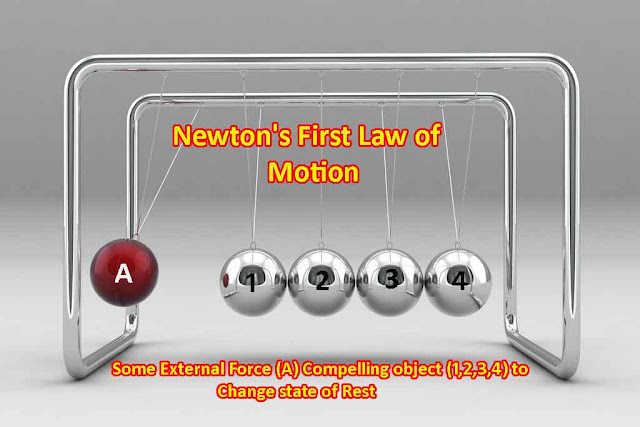Three Laws of Motion - [Newtons 3 Laws of Motion]
At the end of the article, you will able to describe - newtons 3 laws, What are the three laws of motion. Let's start discussing one by one.
This property of matter to remain at rest or in motion is known as inertia.
Must Read- First Law of motion Formula and Examples.
Mathematically stated,
A moving object acceleration equals to the net force acting upon the object, divided by the mass of the object, or ‘a’ equals F divided by m.
This equation dictates that acceleration is directly proportional to force and inversely proportional to mass. When force increases, acceleration increases, and when mass increases, acceleration decreases.
Take an instance, a scenario where you're pushing a 2-kilogram box along the ground, with a force of 20 Newtons. The acceleration of the box equals the 20 N force you exert, divided by the mass 2 kg of the box. The value of acceleration is = 20/2 =10 ms-2
If the mass of the box is increased to 5 N, but the force stays the same, the acceleration will decrease
This shows that the Mass is inverse proportion, to acceleration.
Must Read-
In other words,
For every action, there is an equal and opposite reaction.
When one object pushes against another, the force applied by the first object is opposed by the force of the second object that is equal in magnitude, but in the opposite direction.
Must Read- Third Law of motion Formula and Examples.
This is all about the basics of- newtons 3 laws, What are the three laws of motion.
What are the Three Laws of Motion
Sir Isaac Newton (1642-1727) made a systematic study of motion and extended the ideas of Galileo. He arrived at three laws which are called Newton's laws of motion.- Newton's first law of motion
- Newton Second law of motion
- Newton's Third law of motion
- Newton's first law is often termed, the law of inertia.
- Inertia is the property of matter by virtue of which an object continuous in its existing state of rest or uniform motion in a straight line unless an external force changes that state.
Newtons 3 Laws of Motion
Born in 1642, the English physicist and philosopher Sir Isaac Newton, revolutionized the world's understanding of the physical universe, with his three laws.Newton's first law of motion
Newton's first law of motion states that all objects continue in a state of rest or uniform speed in a straight line, unless acted upon by a non zero net force. In other words, an object at rest tends to stay at rest and an object in motion tends to stay in motion unless acted upon by an outside force.- This law can be observed when a tablecloth is whipped from underneath a dinner setting, while the dishes remain in place. Because the dishes were initially at rest, they will continue in their state of rest.
- Likewise, when a fast-moving metro train comes to a quick stop, passengers inside train continue traveling at the previous uniform speed of the train and get thrown forward.
This property of matter to remain at rest or in motion is known as inertia.
Must Read- First Law of motion Formula and Examples.
Newton's Second Law
Newton's second law states that the acceleration produced by a net force on an object is directly proportional to the net force, is in the same direction as the net force and is inversely proportional to the mass of the object.Mathematically stated,
A moving object acceleration equals to the net force acting upon the object, divided by the mass of the object, or ‘a’ equals F divided by m.
- This basically means that it takes a greater force to move or accelerate objects, with greater mass than it does for objects with lesser mass.
- Force is a vector quantity (Magnitude as well as direction).
- SI units of Force is Newton.
- The SI unit of acceleration is ms-2.
- The CGS unit is cms-2.
This equation dictates that acceleration is directly proportional to force and inversely proportional to mass. When force increases, acceleration increases, and when mass increases, acceleration decreases.
Take an instance, a scenario where you're pushing a 2-kilogram box along the ground, with a force of 20 Newtons. The acceleration of the box equals the 20 N force you exert, divided by the mass 2 kg of the box. The value of acceleration is = 20/2 =10 ms-2
If the mass of the box is increased to 5 N, but the force stays the same, the acceleration will decrease
This shows that the Mass is inverse proportion, to acceleration.
Must Read-
Newton's third law of motion
Newton's third law of motion states that whenever one object exerts a force on a second object, the second object exerts an equal and opposite force on the first.In other words,
For every action, there is an equal and opposite reaction.
When one object pushes against another, the force applied by the first object is opposed by the force of the second object that is equal in magnitude, but in the opposite direction.
Must Read- Third Law of motion Formula and Examples.
- When you exert a force against a wall, the wall pushes back with an equal force but in the opposite direction.
- When you take a step and push your foot down against the floor, the floor exerts a force back up to your foot.
This is all about the basics of- newtons 3 laws, What are the three laws of motion.
![Three Laws of Motion - [Newtons 3 Laws of Motion] Three Laws of Motion - [Newtons 3 Laws of Motion]](https://1.bp.blogspot.com/-7Lg-0yuZpDo/WoGGqd5h9CI/AAAAAAAAA0Q/qAJJSgIeeVoLN3atjkeDtK9_12Q6A_ZowCEwYBhgL/s640/laws.jpg)


Comments
Post a Comment